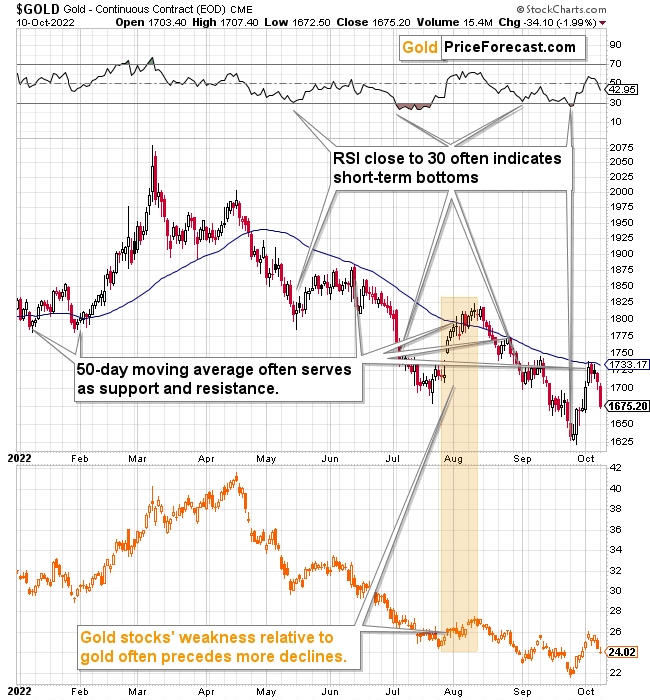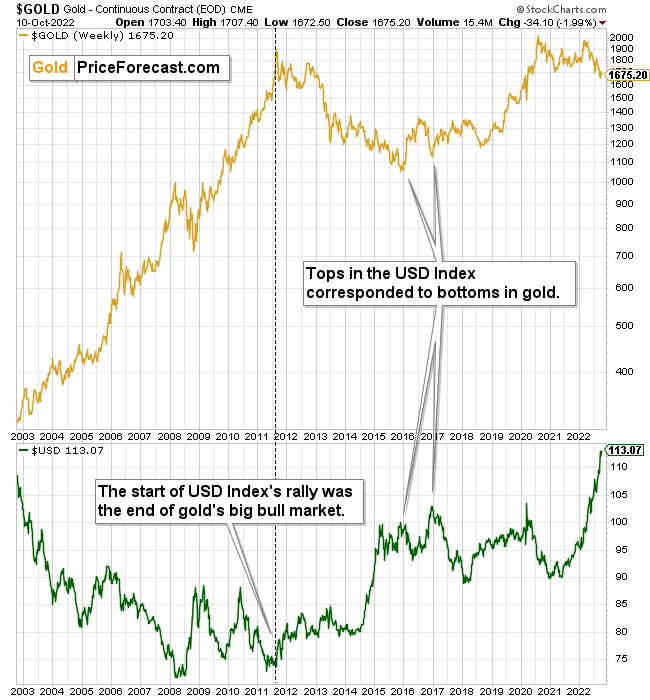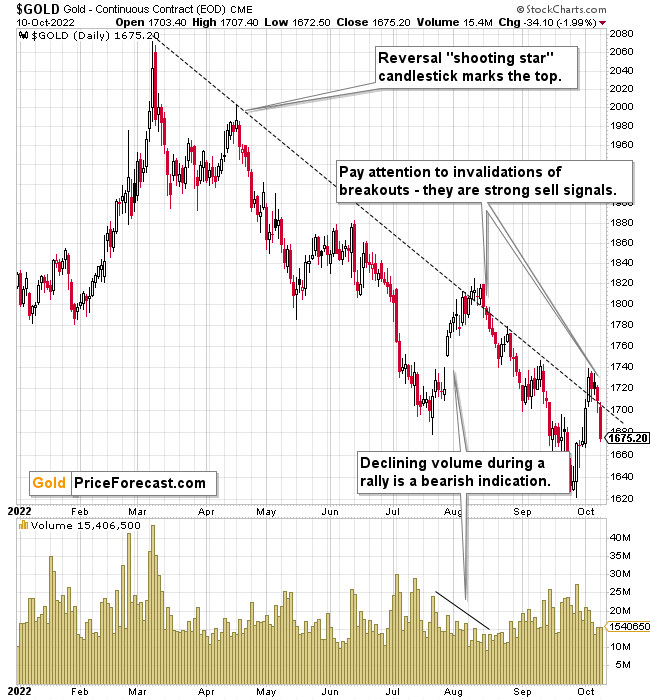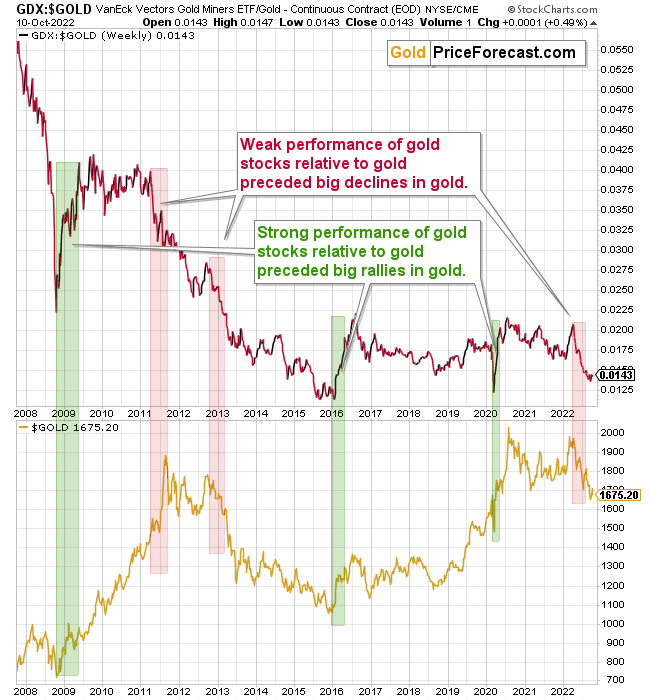Gold Trading Tips, Strategies, and Techniques
Is gold one of the most difficult markets to trade? Some say it is, and there is an element of truth to that – gold doesn’t move like other markets do, and people even argue over whether it behaves more like a commodity or as money. One thing is clear - the gold market is unique. It bears similarities to other asset classes and markets, while also being decidedly different.
If you want to be successful trading gold both in the short-term and long-term (and it can be very lucrative!), you have to keep multiple things in mind and build a special set of skills.
The chart below shows how just a few of the trading techniques would have been useful in 2022:

Of course, there are many more tips than would fit a single chart.
After decades of analyzing the gold market, we noticed many profitable rules and patterns. We successfully applied these and continue to apply them for our precious metals trades, and we’ll share many of our insights on this page. It took years of analyzing, testing and using our own capital to make sure that these techniques are really useful…
… and thanks to this, the strategies and tips that you find below should make trading gold easier and much more profitable.
To clarify, most points that are mentioned below could be described interchangeably as either a strategy, a tip, or a technique. However, we split them into three categories based on the scope of the content. The strategies have wide-reaching implications, tips are descriptions of individual tools that can be used in gold trading, and techniques are things that don’t fall strictly into any of the above categories.
We hope you find these useful and are able to apply them. It’s a broad topic, and you’ll most likely want to deepen your knowledge. Joining our community will help you to get the exact answers you need.
Gold Trading Strategies
First things first – we’re starting off with strategies.
The key gold trading strategy for trading all markets, including gold, is the same and it’s about managing position sizes.
If there was anything that one could call the Holy Grail of Trading, this would be it. It’s where most novice investors make mistakes, and what pros pay extra attention to.
1. Remember to keep the size of your gold trading positions in check.
In general, the higher the chance of you being correct, the bigger the position can be - that’s why sizes of long-term investments are bigger than sizes of short-term trades. If you’re just starting out, then your top priority should be NOT overtrading and NOT getting more leverage than you can handle. In fact, it’s best not to use any leverage at the beginning of one’s gold trading journey.
How much is too much? This isn’t investment advice, just an educated observation based on research and literature, but if the maximum loss on a given trade can exceed 2% of your capital, it’s probably too big. Actually, smaller positions - ones that allow for a maximum loss of 1% or 0.5% of capital might be a better idea for beginning traders. This means that if your stop-loss is hit and there’s a loss, this loss shouldn’t be bigger than a certain percentage of your portfolio (not greater than 0.5% - 2% of your capital).
Yes, we know this sounds boring, and you’re here to make money and not take losses, but the above is critically important. There will most likely be many profitable trades, but you can only have those if you accept that some of them will not turn out right. The key is to make sure that the flops don’t cause irreversible damage to your portfolio.
Dating is a good analogy. The people who get the most phone numbers also get the most rejections. The point is not to get too emotionally damaged after each rejection, which could make a person doubt themselves and stop reaching out to people.
In both cases it’s important to focus on what you can control. In the case of the market, you need to be sure to prepare for the unfavorable scenario by not putting too much capital into a single trade, so that you can continue trading regardless of what happens to an unfavorable trade. Additionally, keeping the trade small enough will help you stay objective and healthy – as big positions often lead to big stress. In fact, this single benefit might even outweigh the other ones.
All right, since the position sizes are in check, let’s go through some more gold trading strategies.
2. Consider long-term investments in gold.
Even if your primary approach is to trade gold, we still encourage you to consider dedicating a part of your capital to long-term investments – it should lower the overall variability of your returns and make gains more stable (this being our opinion, and not investment advice, of course).
3. Everything is connected - factor in the bigger picture of the market.
Analyze more than the market in which you want to trade. In the modern global economy no market can move totally independently. Gold and the rest of the precious metals sector are no exception – their price moves are often linked to the moves on the currency market, moves on the general stock market, interest rates, the Fed’s comments, and performance of gold stocks and general stocks. Be sure to check what markets were moving in tune or in the opposite direction to gold before, and make sure that their impact is likely to be supportive of the trading position that you are about to open. For example, if gold was moving in the exact opposite to the USD Index and you’re considering opening a long position – if you see that the USD Index is very close to a major resistance level and it’s already heavily overbought, then the odds are that the USD Index will top and contribute to or even trigger gold’s decline.

On the above chart you can see how analyzing the USD Index would have been useful when timing major tops and bottoms in gold.
4. Check if an analyst’s approach is a good match for you.
Before you decide to follow a given analyst, be sure to check how long they have been in the business and if they are known for their good performance. It’s just as important to check their overall approach and trading dynamics and verify if that’s what would be suitable for you. For example, if you’re looking for a new trade every other day, but the analyst is focusing on trades that take between a few weeks and a few months, you won’t be happy with their service, even if it’s profitable in the long run. You wouldn’t likely stay around for the “long run” because you would be frustrated by the lack of trades and leave (let’s be realistic). Alternatively, if you want to enter a trade and then hold it for a month or so (so that you are not forced to take action frequently), you would be very annoyed by a service that provides quick hour-long or days-long trades. The same goes for the approach regarding sizes of moves and distance to the accepted stop-loss levels (or lack thereof). The approach of one analyst can be very different from the approach of another analyst, and it’s best if you follow not only someone who can generate value for you, but whose approach resonates with you.
5. Stick with and monitor your chosen analyst’s performance.
If you do decide to follow someone, it’s usually a good idea to stay with them even if they happen to be incorrect about the market once or even consecutively, as markets are sometimes moving almost randomly (they are emotional, not logical in the short-term) and everyone has to be incorrect eventually. This doesn’t necessarily imply following what they do using your capital – it means monitoring their performance to see for yourself if they can grow your capital over time.
6. Understand asset volatility.
Understand asset volatility. Relative to gold futures and gold-backed ETFs, the senior gold miners (GDX ETF) and the junior gold miners (GDXJ ETF) are essentially high-beta (“more leveraged” in a way) plays on the gold price. For example, the senior gold miners will often rise and fall by more than the gold price (over a large enough sample size), while the junior gold miners will often rise and fall by more than the senior gold miners. As a result, you should align your positions with your risk tolerance.
The above-listed gold trading strategies are the “top” of the top-down approach. The below-listed gold trading tips are the “bottom”.
Gold Trading Tips
A picture can tell a thousand words, and the one below will indeed fit a few gold price trading tips.

More gold trading tips:
1. Pay attention to cycles and turning points.
Many markets have a cyclical nature (i.e., the USD Index) and cycles and turning points can be of great help in the case of short- and long-term trades.
2. Check the efficiency of each indicator.
Before applying any indicator on the gold market (or other markets), and trading real capital based on it, be sure to check whether it’s working consistently. Just because it worked before doesn’t guarantee that it will work once again, and if it didn’t, it’s a big warning flag. Just as someone’s good reputation doesn’t guarantee that they will be honest, someone’s reputation as a liar (verified by yourself) suggests that you might be better off getting information from someone else.
3. Consider using RSI and Stochastic indicators.
RSI and stochastic indicators for gold, silver and mining stocks have proven to be useful over many years. MACD might be useful as well, but mostly in the case of very long-term moves. Other indicators can also be handy, but be sure to examine them before you decide to make trading decisions based on them.
4. Modify indicators if necessary.
If a given indicator works “almost as well” as you’d like it, but you see that it has further potential, don’t be afraid to modify it. For example, in the case of RSI, if you see good selling opportunities when this indicator moves to 65 or so (instead of the classic 70 level), then it can be useful and profitable to either (1) add an additional overbought / oversold level, (2) breaking which would generate a signal (in this case a sell signal) or (3) to change the parameters of the indicator, deviating from the standard values.
5. Use moving averages only if they worked for a given market in the past.
If a particular market has been ignoring certain moving averages, most likely so can you. In fact, this is the “golden rule” for all tools and indicators – if they haven’t worked on a given market previously, it might not be the best idea to count on their usefulness next time. In the case of gold, the 50-day moving average works quite often (as both support and resistance), but it doesn’t work every time. It’s therefore a good idea to use it as resistance or support only if other techniques confirm it.
6. Keep track of the price seasonality.
Just like autumn or spring come with their particular set of weather patterns for different parts of the world, the gold market and other precious metals are affected by what is called price seasonality. Understanding these market patterns is important to knowing when it’s a good time to consider trading gold, and in the case of bad weather for the yellow metal, when to short it perhaps.
7. Use trend lines and trend channels.
Trend lines and channels have often proven useful as support and resistance lines / levels in the case of gold, silver and mining stocks. The more significant the lows or highs are when used for creating a given trend line or channel, the stronger the support or resistance is.
8. Previous highs and lows often serve as support / resistance levels.
The more significant a high or low is, the stronger the support / resistance levels. This applies to most (if not all) markets, but we’re including it on the list to emphasize that this technique is useful on the precious metals market as well. Trend lines created by connecting the previous bottoms or tops are another universally useful technique that also applies to the precious metals market. And, just like in the case of resistance / support levels created by tops and bottoms, the more important these price extremes are, the stronger support / resistance the line based on them will provide.
9. Markets are not only cyclical in nature, but are fractal too.
The rallies and declines in the gold market and other markets are self-similar, which means that the price patterns that we saw on a bigger scale are quite likely to be seen on a smaller scale (proportionately). This observation can be of great help when determining how low or how high gold, silver or mining stocks will move. If the current price move is very similar to the previous ones, it’s quite likely that the final part of the pattern – that’s still ahead – will also be similar, which allows you to position yourself to take advantage of it.
10. Pay attention to volume.
The volume is a very important, yet often overlooked, piece of information. If a rally is accompanied by rising volume, then it’s likely the start of an even bigger rally. However, if a rally is accompanied by low or visibly declining volume, then it’s likely ending. If a decline is accompanied by high or rising volume (unless there is a day when the price visibly reverses), then the decline is likely to continue. Conversely, if a decline is accompanied by low volume, then there are no meaningful implications (yes, the situation is not symmetrical in this case). The above are general guidelines, and before applying them to the current market situation, be sure to check if they really worked as outlined – if they didn’t, then it’s generally better to expect the same type of reaction that previously accompanied a certain price/volume pattern.
11. Look for price formations.
Price formations can, for example, take the shape of a head and shoulders formation. But before you apply them (while believing that a certain formation is “in play” and likely to cause a certain move which would cause you to enter or close a given trade), be sure to check if this kind of formation worked in this market previously. For instance, “breakouts” (which are not a formation by themselves, but this example illustrates what we mean) in silver have quite often resulted in price declines (breakouts were invalidated) instead of rallies, so their real implications were the opposite of what one might have expected based on the classic definition of a breakout.
12. Wait for confirmations.
It’s usually best to wait for a confirmation of a breakout / breakdown before taking action. In the case of the precious metals market, and based on our experience, it’s worth waiting for three consecutive closing prices below / above the critical price level before viewing the breakout / breakdown as “confirmed” and thus meaningful. Invalidation of a breakout is a bearish sign and invalidation of a breakdown is a bullish sign.
Knowing the above gold trading tips already puts you above the majority of traders in terms of market insights, and when you combine them with the strategies that we outlined previously, they can yield great results.
But wait, there’s more! :)
The below gold trading techniques supplement what you already learned so far and give you an even greater edge over other gold traders.
Gold Trading Techniques & Tactics
1. Pay attention to real interest rates.
While most investors use the inflation argument to justify their long positions, gold’s fundamental attractiveness declines when nominal yields rise at a faster pace than inflation expectations. For example, fixed income investors often substitute government bonds for gold in their portfolios. However, because gold is a non-yielding asset, when real interest rates rise, bond tourists are more likely to sell their gold positions and reallocate capital to government bonds.
2. Analyze ratios.
Of course, not just any ratios, but rather the ones that have proven to provide important signals for gold. These can be (1) the gold stocks to gold ratio or gold to silver ratio – they both have a history of leading gold, especially the former; or (2) ratios that are important due to fundamental factors (gold vs. bonds ratio – both can be seen as safe-haven assets and major bottoms and tops in this ratio take place along with major tops and bottoms in gold, so it can be used as a confirmation); or (3) ratios that are often discussed (gold to oil ratio). Sometimes ratios can be utilized to see something from a non-USD perspective, like the gold to UDN ratio – which is the weighted average of gold priced in currencies other than the US dollar, with weights as in the USD Index. This ratio can be used to confirm major moves in gold, or suggest that these moves are just temporary, as they are only visible from the USD perspective.
On the below chart you can see how gold stocks (I’m using the GDX ETF as a proxy here) to gold ratio helped to predict gold prices.

The moves higher in the ratio helped to forecast bigger price rallies in gold, and the moves lower in the ratio helped to predict bigger declines in gold.
3. Analyze other time frames rather than just the one that you’re focusing on.
Even if you are placing a short-term trade, be sure to check the medium- and long-term trend. Generally, the longer the time frame, the stronger the support and resistance levels. So, even if you analyze the short-term picture, it can be the case that a given move will be stopped by a medium- or long-term resistance. If you’re focusing on the medium- or long-term trades, the short-term picture can help you fine-tune the moment of entering or exiting the market.
4. Don’t assume that all techniques are useful.
Just because “golden cross” or “death cross” have names that sound edgy, doesn’t mean they’ll be useful for the precious metals market. Based on our research, their application – on average – is either counter-productive or useless. Again, be sure to check if a given technique worked on your preferred market in the past years before applying it. And as mentioned before, something that worked in the past is not a guarantee of it working in the future. Red flags should be raised if it didn’t work at all.
5. Be on a constant lookout for anomalies.
That’s a broad gold trading tactic, but it’s worth keeping in mind. When you see something odd, investigate and find the reason behind it, and check if anything similar happened previously – if it did, check what happened next. If similar things were always followed by the same kind of price pattern in gold, silver, and/or mining stocks, it might be a good idea to trade it. If not, then perhaps the reason behind the anomaly resulted in something else that had a more specific effect on the precious metals prices.
6. Pay attention to extreme inflows or outflows from popular ETFs (like GLD or SLV).
It seems like extreme inflows (people buying ETFs, thus investing in a given market) “should” be bullish, and extreme outflows “should” be bearish, but it doesn’t have to be the case. Conversely, just as with the case of volume, extreme values could mean peak interest. And major tops are formed when everyone and their brother is bullish – so, extreme inflows to the ETFs might actually signal topping, which is a bearish sign, not a bullish one. How can you tell if an event is bullish or bearish? One technique is to compare it to the previous historical events and see what kind of action followed. Another way is to check if the extreme levels of inflows or outflows were reached steadily (likely not a sign of a change in the trend), or if there was a sudden spike in inflows/outflows. In the case of the latter, it could reflect an extreme shift in the sentiment, and thus, an important turnaround.
7. Monitor investor sentiment.
If the majority (!) of precious metals investors and traders are bullish, then gold is likely close to a top. In this case, it makes sense to look for selling signals and / or confirmations that the top is in and – if they are present – exit long positions and / or enter short ones. Conversely, if everyone is bearish on the market, then a bottom is very likely close to being in, or already in. The ways to estimate sentiment include checking how often people look for gold-related terms (like “gold stocks”) in Google Trends, monitoring outcomes of surveys with questions like “where will the gold price be in three months”, and similar queries. On a side note, when you see that a certain, big gold-related website is very slow or crashes after a big move up or down, then it likely means that the traffic / interest in gold was enormous, which is another way of detecting that a major price extreme is well-nigh (we saw that in 2011, when gold topped).
8. Pick the right broker(s).
First you have to decide where you want to invest ETFs and ETNs, mining stocks or derivatives like futures contracts, options or CFDs. You have to carefully check costs, including commissions, transaction spreads, currency conversion costs or account management fees.
The above is not a 100% complete list of what we discovered on the topic of gold trading (we can’t provide all the details publicly), but it includes the majority of things that we repeatedly found to be very useful. Utilizing these points will go a long way to building a solid set of gold trading skills.
Thank you for taking the time to learn more about the precious metals market today. We’re all on a journey of acquiring more knowledge, but you know what? That journey doesn’t have to be taken alone. If you found the above list useful and / or you would like to see how these trading tips (and others not listed here) are applied in practice, we invite you to join our gold trading community.
This way, you’ll not only gain access to exclusive (available only here) gold price forecasts, but you’ll also be able to discuss them with the authors and other investors. And you’ll stay up-to-date with those authors that you particularly like (or all of them, if you so choose).
And yes, it’s free. Sign up today.